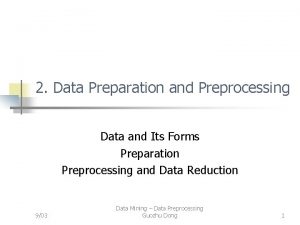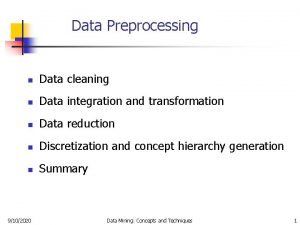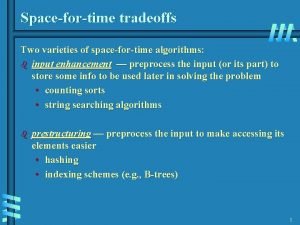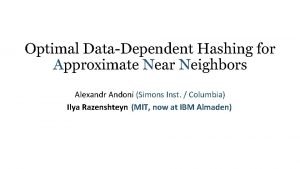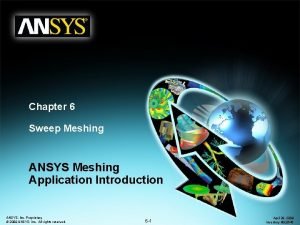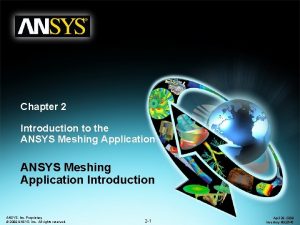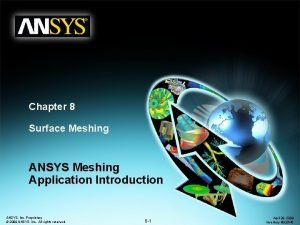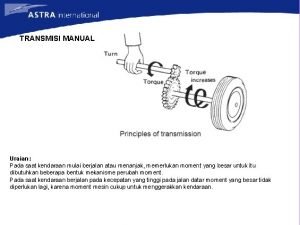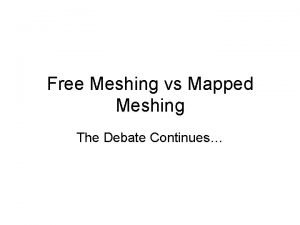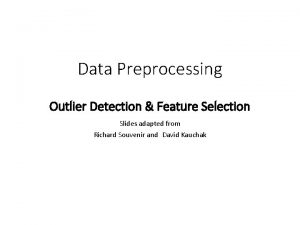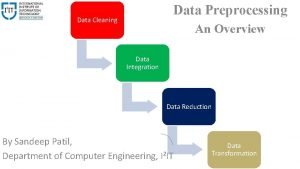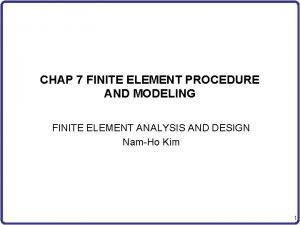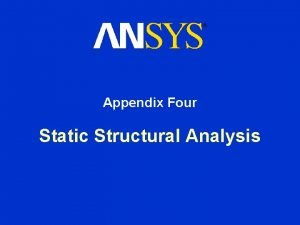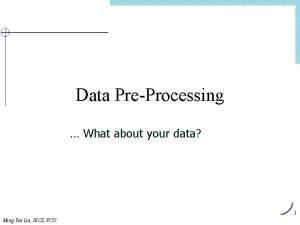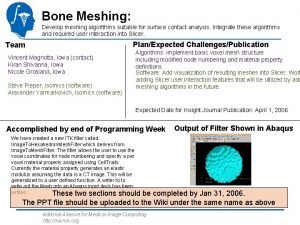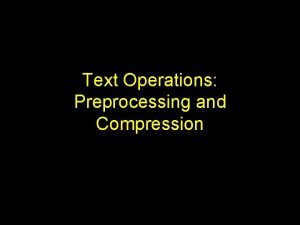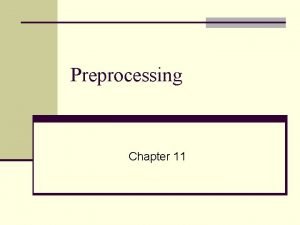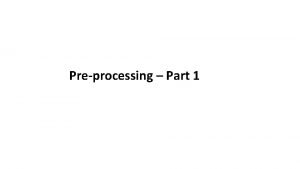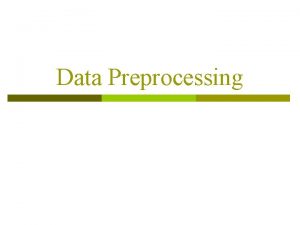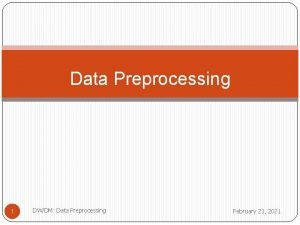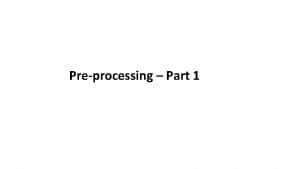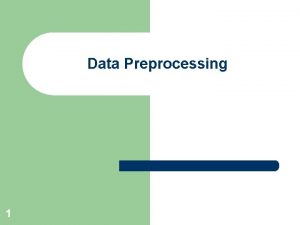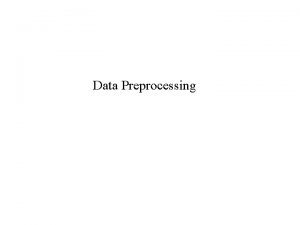Preprocessing and meshing FEmodels with GriddleRhino Applications on
















- Slides: 16

Pre-processing and meshing FE-models with Griddle/Rhino: Applications on complex geometries from salt mine drifts G. Maniatis & S. Fahland Department B 3. 5 Geotechnical Safety Analyses Federal Institute for Geosciences and Natural Resources (BGR) Hannover, Germany

BGR, Department B 3. 5 Geotechnical Safety Analyses Several Projects on Final Nuclear Waste Disposal in salt rock, claystone, crystalline rock and the relevant geotechnical barriers FEM applications for: • Modeling complex geological structures • Complex underground mine geometries • Large 3 D Models • Coupled Thermal, Hydraulic and Mechanical processes • Long modeling times Solving FEM with several codes: • JIFE (BGR in-house developed) • Flac 3 D • OGS • Roxol 2

Preprocessing FEM Models Depending on the size of the model, preprocessing can be time consuming and often requires compromises on the amount of geometrical detail that the final numerical model will contain. In most of the cases of R&D so far, the models are designed by hand in CAD software as • complex 2 D geometries extruded to 3 D or as • complex 3 D geometries However, most of these models consist of solids defined by flat or relatively simple and smooth surfaces. 3

Preprocessing FEM Models Prospective, more elaborate safety analysis of potential nuclear waste disposal sites requires the implementation of more detailed geometries in FE Models such as: • • • shafts drifts mining rooms sealing elements surrounding geological structures These requirements increase the 3 D complexity of the mesh dramatically. In such cases, more powerful preprocessing and meshing tools are required. 528 m 560 m 4

Preprocessing and meshing FE models with Griddle/Rhino Preferably one software package for both geometry and mesh generation • Easy to use • Capability to import real geometries and polygon meshes derived from 3 D scans and surveying campaigns in the salt mine (different file types) • Capability to analyze, repair and idealize imported geometries and/or polygon meshes • Easily produce and refine a good quality volume mesh that can be exported to different FEM software for further preprocessing (e. g. BCs and material properties) and solving 5

Imported Data The drift geometries from a German salt mine that were used for this application were available in the common. dwg file format. Prior to importing the. dwg file into Rhino the appropriate length units have to be set for the model and the layout in the properties menu. The initial polygon meshes were not built for numerical modeling purposes derived from 3 D scans and surveying campaigns in the salt mine. The consist of several small parts not joined with each other and contain several types of errors and defects, which have to be found, analyzed and repaired with the check-mesh and mesh-repair tools in Rhino. 6

Typical mesh errors and defects • Pairs of surface element faces that intersect each other, duplicate surface elements faces and degenerated faces (zero area) Commands Testmsx (Rhino 5. 0) Cull. Degenerate. Faces Extract. Duplicate. Mesh. Faces • Openings (i. e. missing surface elements) in the mesh and “naked edges” at the edges of open polygon meshes • Commands Fill. Mesh. Hole Patch. Single. Face 7

Typical mesh errors and defects Non-conformal mesh locally or along edges • Local non-conformal mesh can be repaired by collapsing local vertices, faces or edges (Collapse. Mesh. Vertex, Collapse. Mesh. Face, Collapse. Mesh. Edge) or by locally deleting the mesh faces and reconstructing the mesh by filling the mesh hole or patching singe mesh faces. • Larger non-conformal edges (naked edges) can be easily corrected with the Match. Mesh. Edge command 8

Typical mesh errors and defects Duplicate mesh areas and overlapping surface mesh Areas consisting of duplicate (i. e. identical) surface meshes are another usual defect in the initial mesh geometries that can be solved mostly by using mesh Boolean operations in Rhino. (Mesh. Boolean. Difference) However, there are extensive, complex and tightly overlapping mesh surfaces that share no identical nodes and therefore cannot be removed by using standard Boolean operations. Use of an algorithm within the Grasshopper plugin, which is available for Rhino. This algorithm searches for the closest neighboring vertices of two partially overlapping meshes and removes or separates them from the rest of the model. 9

Surface mesh with Griddle GSurf Polygon meshes are joined to create closed ones, while avoiding or correcting non-conformal meshes along the matched mesh edges and finally unifying all mesh normals on the element surfaces. Remeshing the previously joined surface meshes with the Griddle GSurf command input mesh Options: Element Type: Element edge length: Level of mesh detail: Variation of element size: 10 output mesh Tri, Quad. Dom, All. Quad Max/Min. Edge. Length Ridge Angle Max. Gradation Surface mesh of entire area of interest (19734 polygons, model size 100 m x 71 m x 15 m) The generated surface mesh can be checked again for any errors with the Rhino Mesh. Repair command.

Surface mesh with Griddle GSurf Mesh refinement Smoothing out sharp edges globally or locally on the surface generated with Gsurf with Rhino’s (Smooth command). 11 Assigning local mesh densities on surfaces, around points or along lines.

Surface mesh with Griddle GSurf All the surface mesh parts of the model must form structures with watertight boundaries to be used for the generation of the final volume mesh with Griddle‘s GVol command. The output may consist of either a Tet (all-tetrahedral) volume mesh or a conformal hex-dominant volume mesh. Possible output file formats: FLAC 3 D, 3 DEC, ABAQUS, ANSYS, NASTRAN The model boundaries can be constructed as a surface geometry with the command Bounding. Box around the modeled mine room and scaled to the appropriate size (Scale. Nu command). The boundary surface of the model can be meshed with Griddle’s GSurf command in the same way as the mining room. 12

Volume mesh with Griddle GVol input mesh • number of surface elements: 22576 • number of nodes: 21633 GVol Mode: Con. Hex. Dom output mesh • total number of elements: 362406 • hexahedra: 91. 94% of volume • prisms: 0. 92% of volume • pyramids: 5. 40% of volume • tetrahedra: 1. 75% of volume • number of nodes: 176110 13

Volume mesh with Griddle GVol A practical solution for the rather abrupt change in the mesh density could be the use of concentric surfaces between the center and the boundaries of the model with gradually increasing mesh density. number of surface elements: 26198 number of nodes: 25205 output mesh input mesh total number of elements: 479631 hexahedra: 79. 81% of volume prisms: 2. 62% of volume pyramids: 13. 15% of volume tetrahedra: 4. 42% of volume number of nodes: 236490 14

Summary & Conclusions 3 D preprocessing and mesh generation with Griddle in Rhino • Effective, quick and straightforward method to produce a volume mesh of complex geometries • Existing data can be easily imported in Rhino and remeshed with Griddle to produce volume meshes that can be moved across different platforms of numerical software • The most time consuming tasks are initial mesh corrections and defeaturing • Volume mesh may show a localized transition of element size instead of a smooth gradation 15

Thank You for Your Attention! 16
 Sequential feature selection
Sequential feature selection Data integration in data preprocessing
Data integration in data preprocessing Password hashing and preprocessing
Password hashing and preprocessing Password hashing and preprocessing
Password hashing and preprocessing Ansys sweep mesh
Ansys sweep mesh Ansys workbench mesh refinement
Ansys workbench mesh refinement Mapped face meshing
Mapped face meshing Momen yang besar dibutuhkan kendaraan pada saat
Momen yang besar dibutuhkan kendaraan pada saat Inflation algorithm pre post
Inflation algorithm pre post Mapped meshing
Mapped meshing Text preprocessing steps
Text preprocessing steps Document preprocessing
Document preprocessing Outlier
Outlier Data integration in data preprocessing
Data integration in data preprocessing Image preprocessing
Image preprocessing Image preprocessing
Image preprocessing Data pre processing
Data pre processing
